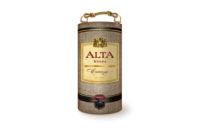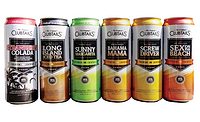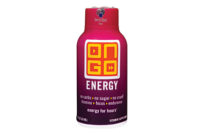Discovering the aluminum package advantage
Material expands into new beverage categories, formats

To demonstrate the strength of aluminum cans, The Aluminum Association parked a car on top of four six-packs of aluminum cans. (Image courtesy of The Aluminum Association)

The Boston Beer Co. plans to launch its Samuel Adams Boston Lager in a specially designed “Sam Can” by Ball Corp. this summer. (Image courtesy of The Boston Beer Co.)

Wis-Pak Inc. released its DOC 360 carbonated soft drink line in Ball’s 16-ounce Alumi-Tek bottle, which the brand has dubbed the “Slam Can.” (Image courtesy of Ball Corp.)



In the days since the first can of beer was sold in 1935, aluminum cans have grown in popularity and evolved into a sustainable packaging choice for beverage-makers. “The evolution of the aluminum can is much like that of the American automobile — in the last 35 years, its weight has been drastically reduced, but strength and performance have improved dramatically,” says Beth Schmidt, director of recycling for Alcoa Inc., New York. “Today’s aluminum alloys are enabling products to be lighter, more durable and better performing. In fact, today’s aluminum can is 15 percent lighter than it was in 1993.”
As lightweight as this packaging material has become, it still is engineered to be stackable and strong enough to support the weight of other cans placed on top of it while protecting the product inside, says Steve Gardner, vice president of communications for The Aluminum Association, Arlington, Va. In fact, these packages are so strong that The Aluminum Association parked a car on top of four six-packs of aluminum cans to demonstrate their strength, he says.
However, in the last 10 years, innovation in aluminum beverage cans has been more about expanding into new categories than lightweighting the containers. According to the Can Manufacturers Institute (CMI), Washington, D.C., more than 45 percent of all carbonated soft drinks and more than 30 percent of beer in the world are packaged in cans. In recent years, aluminum cans also have expanded into other categories, such as coconut water, enhanced and sparkling waters, and protein drinks, Alcoa’s Schmidt says.
Aluminum cans also have grown in popularity in the energy drink category, CMI says. “Cans have come to define the energy drink market, with very few brands introducing products in glass or plastic bottles,” CMI stated in its report, “Aluminum Beverage Cans.” “The durability and portability of the can combined with its sleek and masculine image has helped solidify cans as the package of choice for energy drinks.”
The craft beer market also has been showing increasing interest in aluminum cans as a packaging choice because cans offer protection from oxygen, ultraviolet light, and potential damage during shipping, The Aluminum Association says. “[Craft brewers] care a lot about the taste of their product, so they’re very sensitive to protecting that taste from any light exposure,” says Heidi Brock, president of The Aluminum Association. “They want to make sure there’s no breakage because, again, they care a lot about the taste and protecting that taste and getting that product to market.”
This year, Boston-based The Boston Beer Co.’s Samuel Adams brand is joining the canned craft beer revolution with the planned launch this summer of its Boston Lager in a specially designed aluminum can. “The Sam Can,” which was designed by Broomfield, Colo.-based Ball Corp., has a wider lid and a different position for the can opening than most other cans in order to create an aluminum can drinking experience that closely mimics drinking from a glass, the company says.
“The debate over bottles vs. cans has been a sticking point for brewers in the craft beer community for years,” said Jim Koch, brewer and founder of The Boston Beer Co., in a statement. “In the past, I had my doubts about putting Sam Adams in a can because I wasn’t convinced Boston Lager would taste as good as it does from a bottle. But cans have changed, and I believe we’ve designed a can that provides a slight but noticeably better drinking experience than the standard can.”
The Samuel Adams team worked with Ball Corp. to understand can design and technology and then reached out to sensory experts at Palo Alto, Calif.-based Ideo to discern how the newly designed can could possibly impact the flavor based on the ergonomics of the beer’s flow from the can and how it hits the taste receptors on the consumer’s tongue.
The advent of the mobile canning unit also has spurred some of the growth in the canned craft beer movement, The Aluminum Association’s Gardner notes. These small, mobile canning units are set up in a brewery’s parking lot and hook up to the production line, which is then able to can as little as one pallet of cans for the brewer to sell or keep in stock, he says. “It’s giving [craft brewers] choices, whereas before their only choice was bottles, but now they can choose cans, so that’s why you see a lot of people going into cans now that they have a choice.”
In other categories, making use of different sizes of cans has been a popular trend, says Michael Hranicka, president of Ball’s American metal beverage packaging division. “Marketers are looking for ways to differentiate their brands, and a great way to do that is with can sizes,” he says. For example, last year Ball released the 568-ml Royal Pint can for craft beer customers.
Within the energy drink category, it’s the tall, sleek can sizes and shapes that customers are requesting, says Neill Mitchell, vice president of marketing and strategic development for Philadelphia-based Crown Beverage Packaging North America. In particular, the 16-ounce can size has been especially popular in this category, he says.
For beverage-makers that want to offer their consumers portion-controlled options, Ball also offers smaller cans, such as its 5.5-ounce and 7.5-ounce packages, Hranicka adds.
Jay Billings, director of innovation and marketing for Ball’s American metal packaging division, notes that Ball’s Alumi-Tek reclosable aluminum bottle also has been very successful during the last several years as a portion-control option. “Consumers are on-the-go and often don’t want to finish a beverage all at once, so reclosable aluminum bottles have grown in popularity, providing the drinking experience of a bottle with the sustainability and convenience of a can,” he explains.
Last month, Watertown, Wis.-based Wis-Pak Inc. released its DOC 360 carbonated soft drink line in Ball’s 16-ounce Alumi-Tek bottle, which the brand has dubbed the “Slam Can.” For added differentiation, the brand also worked with Ball to include thermochromic ink that changes color when the contents are cold enough to drink, the company says.
Ecologically efficient
In addition to being a popular beverage packaging choice, aluminum beverage containers are the most recycled beverage container and boast a 65.1 percent recycling rate, according to The Aluminum Association, CMI and the Washington, D.C.-based Institute of Scrap Recycling Industries Inc. This means that 61 billion beverage cans were recycled in 2011, the companies say.
Once recycled, an aluminum beverage container can be processed and returned to the store shelf in as few as 60 days, CMI says. On average, aluminum cans contain approximately 68 percent recycled content, and that recycled content can be reused endlessly, The Aluminum Association’s Brock says. Plus, making aluminum beverage containers with recycled content uses 95 percent less energy than using virgin material, further reducing the industry’s carbon footprint, Alcoa’s Schmidt adds.
The recyclability of aluminum beverage containers also has made them a favorable option for consumers. A national survey commissioned by The Aluminum Association found that 74 percent of consumers rated aluminum cans as a favorable packaging type, compared with glass bottles at 58 percent and plastic bottles at 54 percent. In addition, seven out of 10 adults said they would purchase a product because its packaging is better for the environment, it says.
To help aluminum beverage containers maintain their status as one of the most ecologically friendly packaging options, The Aluminum Association and CMI both say they will continue to spread the message to consumers about the importance of recycling their cans and bottles, pushing toward their goal of a 75 percent recycling rate by 2015.
Looking for a reprint of this article?
From high-res PDFs to custom plaques, order your copy today!










